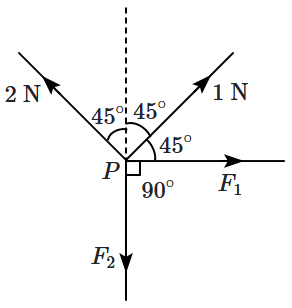Select Question Set:
The tension at the mid-point \(\mathrm{P}\) of the rope is:
(Consider the system is in equilibrium condition, mass of rope\(=4\) kg and \(g=10\) m/s2.)

1. \(100\) N
2. \(120\) N
3. \(140\) N
4. \(190\) N
Subtopic: Tension & Normal Reaction |
81%
Level 1: 80%+
Please attempt this question first.
Hints
Please attempt this question first.
Unlock IMPORTANT QUESTION
This question was bookmarked by 5 NEET 2025 toppers during their NEETprep journey. Get Target Batch to see this question.
✨ Perfect for quick revision & accuracy boost
Buy Target Batch
Access all premium questions instantly
A disc revolves with a speed of \(0.5\) revolutions per second and has a radius of \(15\) cm. Two coins are placed at \(3\) cm and \(12\) cm away from the center. If the coefficient of friction between coins and the disc is \(0.2,\) then:
| 1. | coin at \(3\) cm will slip. |
| 2. | coin at \(12\) cm will slip. |
| 3. | both coins will slip. |
| 4. | no coin will slip. |
Subtopic: Friction |
Level 3: 35%-60%
Please attempt this question first.
Hints
Please attempt this question first.
The system is at rest initially, due to the force of friction acting on \(A\). If the string connecting the lower blocks is cut, the accelerations of the blocks \(A\), \(B\) & \(C\) will be, respectively,


| 1. | \(\dfrac g 3\) to left, \(g\) upward, \(g\) downward. |
| 2. | zero, zero, \(g\) downward. |
| 3. | zero, \(g\) upward, \(g\) downward. |
| 4. | \(g\) to right, zero, \(g\) downward. |
Subtopic: Spring Force |
68%
Level 2: 60%+
Hints
When a body of mass \(m\) just begins to slide as shown, match List-I with List-II:
| List-I | List-II | ||
| (a) | Normal reaction | (i) | \(P\) |
| (b) | Frictional force \((f_s)\) | (ii) | \(Q\) |
| (c) | Weight \((mg)\) | (iii) | \(R\) |
| (d) | \(mg \mathrm{sin}\theta ~\) | (iv) | \(S\) |

Choose the correct answer from the options given below:
| (a) | (b) | (c) | (d) | |
| 1. | (ii) | (i) | (iii) | (iv) |
| 2. | (iv) | (ii) | (iii) | (i) |
| 3. | (iv) | (iii) | (ii) | (i) |
| 4. | (ii) | (iii) | (iv) | (i) |
Subtopic: Application of Laws |
86%
Level 1: 80%+
NEET - 2022
Hints
Given below are two statements:
| Assertion (A): | Improper banking of roads causes wear and tear of tyres. |
| Reason (R): | The necessary centripetal force in that event is provided by the force of friction between the tyres and the road. |
| 1. | Both (A) and (R) are True and (R) is the correct explanation of (A). |
| 2. | Both (A) and (R) are True but (R) is not the correct explanation of (A). |
| 3. | (A) is True but (R) is False. |
| 4. | Both (A) and (R) are False. |
Subtopic: Banking of Roads |
70%
Level 2: 60%+
Hints
The friction force on \(2~\text{kg}\) block is:

1. \( \dfrac{15\sqrt{3}}{2} ~\text N\)
2. \(7 \sqrt{3}~\text N\)
3. \(10~\text N\)
4. none of these

1. \( \dfrac{15\sqrt{3}}{2} ~\text N\)
2. \(7 \sqrt{3}~\text N\)
3. \(10~\text N\)
4. none of these
Subtopic: Friction |
55%
Level 3: 35%-60%
Please attempt this question first.
Hints
Please attempt this question first.
The system of blocks is pulled up by force as shown in the figure. The force exerted on the \(3\) kg block by the connecting string is:


| 1. | \(80~\text{N}\) | 2. | \(60~\text{N}\) |
| 3. | \(40~\text{N}\) | 4. | \(100~\text{N}\) |
Subtopic: Application of Laws |
70%
Level 2: 60%+
Hints
A block is placed on a smooth horizontal surface, and forces are applied to it as shown in the diagram. Take \(g=10~\text{m/s}^2.\) The normal reaction acting on the block is:

1. \(100~\text N\)
2. \(60~\text N\)
3. \(40~\text N\)
4. \(20~\text N\)

1. \(100~\text N\)
2. \(60~\text N\)
3. \(40~\text N\)
4. \(20~\text N\)
Subtopic: Tension & Normal Reaction |
71%
Level 2: 60%+
Hints
Four forces are acting at a point \(P\) in equilibrium as shown in the figure. If the ratio of force \(F_1\) to \(F_2\) is \(1:x,\) then the value of \(x \) is:


| 1. | \(4\) | 2. | \(3\) |
| 3. | \(2\) | 4. | \(1\) |
Subtopic: Application of Laws |
68%
Level 2: 60%+
Please attempt this question first.
Hints
Please attempt this question first.
Unlock IMPORTANT QUESTION
This question was bookmarked by 5 NEET 2025 toppers during their NEETprep journey. Get Target Batch to see this question.
✨ Perfect for quick revision & accuracy boost
Buy Target Batch
Access all premium questions instantly
Given below are two statements:
| Statement I: | When a railway engine pulls a train and the system moves forward, the force exerted by the engine on the train is greater than that exerted by the train on the engine. |
| Statement II: | The normal force exerted by the ground on a man is the reaction force of the weight of the man. |
| 1. | Statement I is incorrect and Statement II is correct. |
| 2. | Both Statement I and Statement II are correct. |
| 3. | Both Statement I and Statement II are incorrect. |
| 4. | Statement I is correct and Statement II is incorrect. |
Subtopic: Application of Laws |
Level 4: Below 35%
Hints
Select Question Set:






